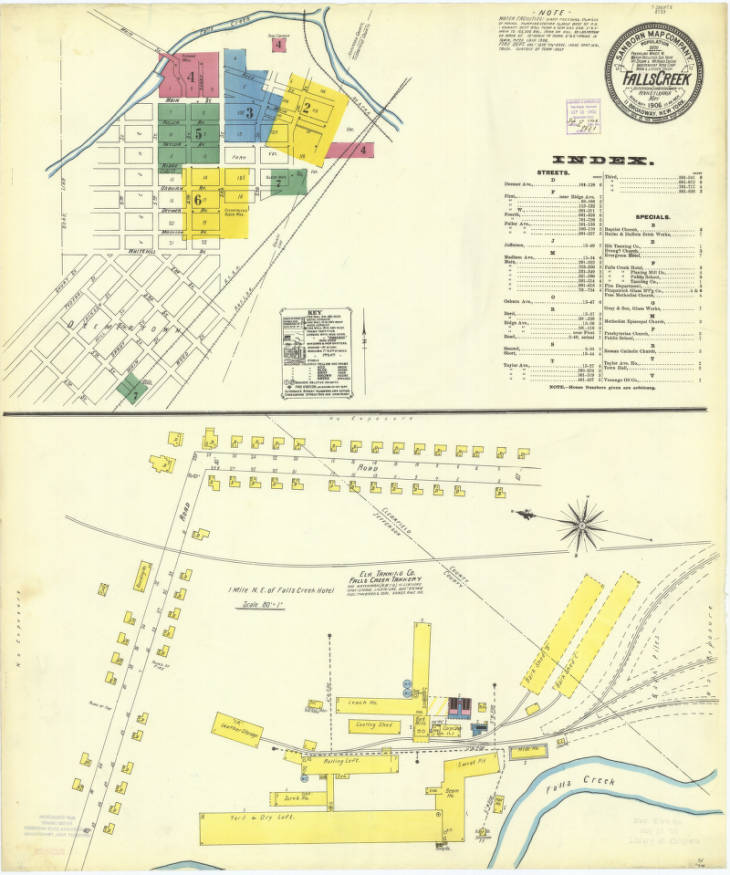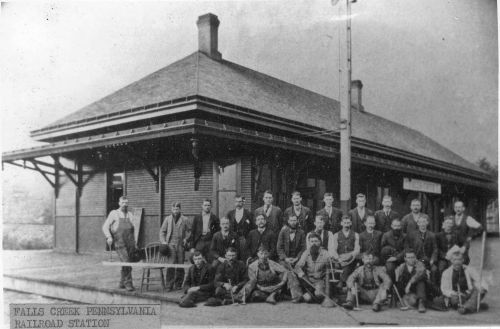.jpg)
.jpg)
DuBois Historical Society, Inc.by Gene M. Arvich
HISTORY OF FALLS CREEK BOROUGH.
Located in Clearfield and Jefferson Counties
Falls Creek was founded in 1848, but it was not until years later that Joseph Taylor were responsible for much of its development.
The first settlers arrived in the Falls Creek area in 1824 and Falls Creek Borough was established of Washington Township in Jefferson County in 1839.
At its conception, Falls Creek was divided into two communities, known as Falls Creek and Evergreen. When an application was made for a post office, it was learned that there was another community in Pennsylvania named Evergreen, so the name was changed to Victor.
Until this time, residents of Evergreen were required to pick up their mail at the Rumbarger (DuBois) office. In 1889, when J.F. Reed was named postmaster, the community was officially rechristened Falls Creek.
In 1890, Taylor and his brother-in-law, Fuller, laid out the streets. Taylor is credited with luring Thomas Proctor to build a tanner in Falls Creek in 1891 and other stores and businesses followed.
Since at that time the railroads were bringing hundreds of men to the area to help ship coal to all parts of the country, the pioneer residents envisioned that the growth of the town would be centered around its busy railroad crossing, which was established in 1883 with the completion of the B.R. & P.R.R. and the crossing of the Allegheny Valley Railroad a year later.
With the construction of a two-story brick store and residence built by Mr. J. L. Reed to spur grown, other homes quickly followed and the town was named Evergreen. A large, four-story hotel, the Lamontague, was erected at the corner of Main and First Streets and provided porches with easy seats from which to view the crowded streets each night. Until it burned down nearly a dozen years later, the Lamontague was the center of activity for the community. Two other hotels served the town during its boom days, the Emory on Main Street and the Casey House on Taylor Avenue. It was not until 1890 that streets were laid out and tree stumps finally cleared from the land. A few houses and stores stood along the street lines, but in rainy weather, rubber boats were required to reach them.
In the late 1800s, Falls Creek prospered with its lumber yards, saw mills, glass plants, tannery, brick plant, and a huge stone quarry, and seemed to be surpassing DuBois in population and size. A new road to DuBois was planned, and with the tannery working at full employment, prospects were bright for continued expansion in that part of town. Although a new water supply and sewage system were planned and a number of new homes were erected on Jefferson Avenue, the feverish boom across the creek in Jefferson County seemed to rob the new division of its initiative.
In April 1892, G. B. Daughtery arrived in the area and, with Ulrich Matson, erected a brick plant. With clay and sand products readily available, the company expanded its operations and became one of Falls Creek’s major industries over the years. One of the largest industrial plants which the area attracted was the Proctor Tannery. Its building covered over 25 acres and received shipments of hides from all over the world, including Texas, Mexico, and Argentina. It was stated that the Falls Creek tannery was the largest in the world, with 1,000 hides being shipped to the plant each day.
The first glass company was built in 1897 by a Mr. Stouffer, and it covered about three acres. In 1899 it was purchased by Ralph Gray and his son, George. The company manufactured specialty glass for many years, then stood idle for some time. In the mid-1930s, it was purchased by the Gray Printing Company.
The huge Fitzpatrick Window Glass Factory was built in 1900 at a cost of over a million dollars, near the site of the later Jackson China Company. This company brought in a small army of glass workers. The plant touched off a new boom in the town with hundreds of visitors attracted to the swing of the single and double strength cylinders of molten glass. The company had its own sand quarries and with excellent rail facilities available in both the R.B.R. and P.R.R., prospects for the industry and town were extremely bright.
One of the great builders of Falls Creek was Mr. G. A. Gocella. The town was founded on great layers of sandstone, and during the next half century, huge quantities of building stone and crushed stone were used in railroad construction and bridge work. Mr. Gocella was one of the first to exploit these fields and provided stones for not only railroads throughout the east, but also for many contractors in the expanding building operations. The Gocella Mansion remained as a landmark for many years.
After the discovery of a process to make window glass by machinery, the day of the hand-operated glass plants was over. In 1914 the Fitzpatrick plant was taken over by the DuBois Glass Company, and shortly thereafter was sold for junk. When the cement age arrived, the town suffered a great blow. Railroads, industry and building contractors substituted less expensive cement for the more costly stone product.
Criminal Activity
Falls Creek was a hangout for some of the worst gangs of criminals in the state. Shortly after the Civil War ended and prior to the coming of the railroads, a string of unfortunate events occurred. One took place a few miles from town at the old “Billy McDonald Farm” and which was later to be known as the “Old Haunted House.”
At about the time the Old Osborne Mill was constructed, an old hunter named Tommy Moore built a shack on this farm and shortly thereafter, committed suicide. Later, an old Scotch Highlander named William McDonald tore down the shack and built a superior log cabin. One day he knelt down beside a log and the spot once again claimed a life.
Mrs. McDonald lived alone for several years, but with the end of the War a number of unsavory characters had drifted into the backwoods. Two of these men were named Chase and Graves, and when they learned of a sum of money Mrs. McDonald had in her possession, they broke into her cabin and killed her. Both were captured and Chase was hanged in Brookville in August 1867. Graves served an extended sentence in the penitentiary. It was the beginning of a long series of criminal activity.
Many stories are uncredited. It was said that horse thieves in Clarion County ran their horses into the area, colored them and sold them elsewhere.
It is also said that one day two brothers by the name of Benson got drunk and tackled a big Swede at his backwoods. The Swede defended himself with an axe, and mangled one of the brothers. Although the Swede brought him to a doctor in DuBois, it was too late, so he went on down the street and dropped him at an undertaker. It was not an easy life in those early days.
By the early 1900s, murder and theft had become so common that most men went around armed. One day a Pittsburgh paper carried the headline, “Carnival of Crime in Falls Creek.”
For weeks, a notorious band of criminals known as the “Benson Gang” terrorized this part of the state. They murdered a policeman in Lock Haven, then returned to this area and murdered a Civil War Vet named Capt. W. J. Leahy. A posse was quickly formed and started to comb the town for a group of four men. It was said that Fred Covert was standing at the corner of Main and Third Street in the early morning hours when he heard shots up the street. He then saw three men carrying a fourth up Short Street toward the planing mills. Additional shots were fired but the men managed to make their escape.
The next day, a small boy by the name of Willie Larkey discovered the hideout of the men in the dense undergrowth across the tracks near the depot. He notified the police and soon the posse had surrounded this place, armed with everything from old Civil War muskets to brand new hunting rifles. One man managed to escape, but two other members of the gang were captured and sent to prison for terms of twenty years each. It was later learned that this was the same gang that had killed the Lock Haven policeman.
With the closing of the tannery and police clamping down on freight hopping, the crime wave simmered down, and the “Outlaws Hangout” became a thing of the past.
Music
The tannery had its own band of musicians led by Nick Leonard.
There was the Falls Creek Coronet Band, under the direction of Howard Stratton. Another drum corps, headed by members of the Schmitt family, also participated in all holiday parades.
James Lukehart was the Drum Major of the Coronet band and he is said to have worn a suit decorated with four rows of shiny brass buttons. On his head he wore a large bearskin shako, with a large golden eagle dangling from the apex. He was a large individual with full whiskers, and when he led the band down the parade route with his whirling baton, he received cheers from the crowds.

Falls Creek Sanborn Map showing the county lines for Clearfield and Jefferson Counties, 1906

Falls Creek Railroad Station. Building demolished in the early 1980's.